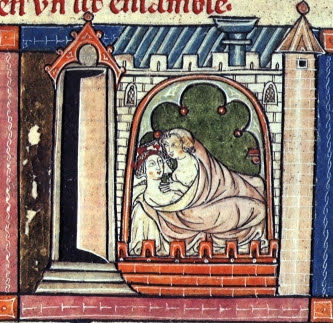In this exciting installment of Google Penance, we learn that Google served some poor soul my post on the difficulty of finding a good e-text of the Aeneid with Yahoo! when what they wanted to know was, “Did They Have Fan Fiction in the Middle Ages?”
For those of you who don’t troll the darker depths of the internet, “fan fiction” or “fanfic” is a term used to describe stories written in or about another author’s world, primarily stories that involve two characters from said world having sex, especially if said characters were very unlikely to have had sex in the original work.*
So, did they have fan fiction in the Middle Ages? The answer is “yes,” though their tastes tended less towards slashfic (the improbable pairings mentioned above) and more toward self-insertion fanfic, the variety in which the author of the derivative work makes themselves a character in the original fictional world, usually a character who is so much better at everything that the characters in the original did, mostly those characters exist just to say things like, “Wow, Author of this Fanfic, you are so pretty and smart and good at riding dragons and fixing warp cores, I don’t know why nobody will go to prom with you. They are fools, fools I say!”**
John Lydgate is the worst medieval offender that I can think of off the top of my head. For the prologue to his Siege of Thebes, he wrote himself into Chaucer’s Canterbury Tales.
And so while the pilgrims were
At Canterbury, well lodged one and all,
I don’t know what to call it,
Luck or Fortune — in the end
That led me to enter into that town
To visit the holy saint humbly
After my sickness, to fulfill my vows
In a robe of black–not of green!
[i.e. Not dolled up like Chaucer’s monk!]
On a slender young horse, long and lean,
With a rusy bridle not worth a dime
[Again, hey, look, at me, I’m much more devout than some monks.]
My servant before me, his purse empty,
Having just by a stroke of luck booked me at the same inn,
Where the Pilgrims were lodged, every last one!
Chaucer seems to have attracted this sort of activity more than other writers–or possibly, we modern readers are more interested in tracking down this sort of thing when it’s done to a writer we admire as much as Chaucer. Chaucer left a lot of gaps in the Canterbury Tales, and other writers stepped up to fill them, writing tales for the poor Ploughman who never got one in the original, an extra tale for both the Merchant and the Cook, and a whole story about what the Pilgrims did once they got to Canterbury. Robert Henryson, a 15th-century Scottish writer, went so far as to write a sequel to Chaucer’s earlier work, Troilus and Criseyde, in which he punishes Criseyde for all the things Chaucer had her do to poor, noble Troilus.
Serious medievalists may take issue with my characterizing the Chaucerian continuations as fanfic, and yes, I’m being a bit glib here. Nonetheless, the thing that always strikes me about medieval writing is how densely referential and intertextual it all is. Of course, my interest in hyper-referentiality is narcissistic, because being unable to finish a sentence without mentioning Mr. T or Mr. Belvedere or some other piece of pop culture detritus is one of the supposed defining characteristics of Generation-X (generation mine) and the eldest members of whatever you want to call the next generation.*** Yet anyone who’s read the Canterbury Tales knows that the thing needs footnotes aplenty just to begin to get all the inside jokes and pop cultural references. Chaucer may not be obsessed with the A-Team or Strawberry Shortcake, but he’s still unable to get through a paragraph without a sly aside that requires you to have read the Romance of the Rose or Boethius in order to understand.
I think medieval courses might have even higher enrollments if we would just get over it and admit that Chaucer shares as much of an affinity with South Park Robot Chicken and the Simpsons Family Guy as he does with Shakespeare.****
—
*In the early nineties, these two characters would invariably be Captain Kirk and Mr. Spock. Even elaborate multi-part Pride and Prejudice / Shirt Tales crossovers would interrupt the touching tête-à-tête between Elizabeth Bennet and Bogey Orangutan by having the two discover while strolling through Pemberly Woods two rumpled Star Fleet uniforms laid one atop the other, one blue, one gold. As the nineties gave way to the aughties, trends shifted, and Harry Potter characters came to supplant Spock and Kirk, but the basic pattern remained the same.
**Don’t let my facility with the form fool you into believing that I myself have dabbled in fanfic. I once had an idea for a Benson/Aliens crossover, but somebody stole it and made it into Half-Life 2 and that soured me on the project.
***My longtime favorite definition of Gen-X comes from a 2003 Salon article: “Although there has been some debate since as to what age group actually makes up Gen X, most sociologists now agree that Americans born between 1961 and 1981 qualify, with extra bonus points going to anyone who remembers the names of the human characters on “Land of the Lost” (Sleestaks don’t count) and who can rattle off all of Ted McGinley’s sitcom credits.”
****Final sentence altered to update the reference for Gen-not-Y-but-not-yet-well-named. A pity I had to lose the alliteration.
















Recent Comments